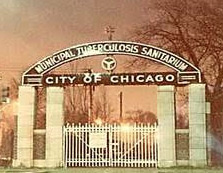The following article was written by Bryan Mulcahy, M.L.S., Reference Librarian at the Ft. Myers Regional Library, used by permission:

Tuberculosis has been an ongoing disease throughout history all over the world. Most genealogists will encounter references in death certificates and other documents to ancestors who died from this disease. Some historical names for this disease include consumption, phthisis and TB. It impacted all social and economic classes, all age groups, and all facets of American life, both urban and rural; it knew no boundaries.
Prior to the late nineteenth century, the term consumption was generally used to describe a class of symptoms that resulted in illness “consuming” the patient from within. Victims suffered from a long period of “wasting away,” Symptoms included bloody coughs, weight loss, fevers, and pallor. Doctors had little medical expertise available to fight the illness. The most common treatments included improving general health through a temperate climate, exercise, and a nutritious diet.
The climate cure was the most popular. By the 1870s, train travel opened up many facilities away from the general public such as the Adirondacks in New York, the Rocky Mountains of Colorado, New Mexico, Arizona, and Southern California. The westward movement of those seeking a cure dovetailed nicely with the region’s need to attract new settlers and trade. Western communities were eager to attract the consumptives, and city officials and business owners sponsored advertisements in the East that touted the curative properties of their particular towns. Reports of the miracle cures to be found in the West appeared everywhere in popular literature. Some of these facilities were like hotels versus what became known later as sanatoriums . Unfortunately, many of these early travelers were the wealthy.
Most common folk waited until the disease was quite advanced before they decided to move West, then they endured a long and uncomfortable train ride, arriving without much savings and without the strength to work, which often led to poor diet and lodgings. Furthermore, many consumptives left their friends and family behind in the East, and found it difficult to make their way alone, homesick, and ill.
The age of sanatoriums came to the forefront in 1882 when Robert Koch discovered that tuberculosis was contagious resulting in new measures taken to lessen its spread. Tubercular patients began to be isolated from the rest of the population in sanatoriums. Hundreds of sanatoriums, small and large, public and private, were built all over the United States. While most were properly maintained and followed all legal and health related mandates, some were viewed in the same light as insane asylums or prisons and the patients were treated accordingly.
Although actual tuberculosis patient records are difficult to obtain, researchers may have more success in finding general information about an ancestor’s stay in a sanatorium. If you know the name of the sanatorium, you can search for annual reports or bulletins from the years when your ancestor was in residence. Many libraries, archives, and historical societies hold this type of information. To gain further insight, you can also search for memoirs and books on tuberculosis treatment from the appropriate time period.
Some urban jurisdictions such as New York City, Chicago, etc. required that the names of tuberculosis patients be entered on health department lists because of its proliferation in various tenements full of immigrants. By 1904, fifty-nine cities ordered doctors to report the names and addresses of those who had tuberculosis. Some people changed their names and addresses to hide from the inspectors.10 Because of the stigma, others chose not to inform family members and friends that they had been diagnosed with the disease. This stigma continued until 1944, when the antibiotic streptomycin was discovered the impact of tuberculosis began to wane in the United States.
By 1954, most of the sanatorium facilities had closed nationwide. Many different types of institutions throughout the country cared for tubercular patients, from large state-run institutions to small private facilities. In some cases, patient records have been preserved by public or private organizations; while in many other cases they were discarded. The Rootsweb Historic Asylums website http://www.rootsweb.ancestry.com/~asylums/ is a good source to begin your search for surviving records. Another good strategy is to search on Google for the following terms “Tuberculosis Hospitals” or “Historical Tuberculosis Records”. Both options will result in potential sites throughout the United States, Canada, and the British Isles.
I just want to say thank you !
TB played a part in my families lives ! I even in one year was pricked 4 times in one year due to my reaction. My body fought it on it’s own thanks to inheriting one of my ancestors genes, but my great grand aunt & her oldest daughter wasn’t so lucky nor my grandfathers cousins parents. My 1st cousin survived it, just too bad it hasn’t been totally wiped out in this day & age !
May I post link to this at facebook ?
Cathy
Sure – post it. Bryan would like to see anyone get the info that wants it.
Thank you for sharing this. I’ve discovered that several of my ancestors (and one of my aunts) had TB. I wanted to let you know that I have included it in my NoteWorthy Reads for this week: http://jahcmft.blogspot.com/2015/06/noteworthy-reads-16.html